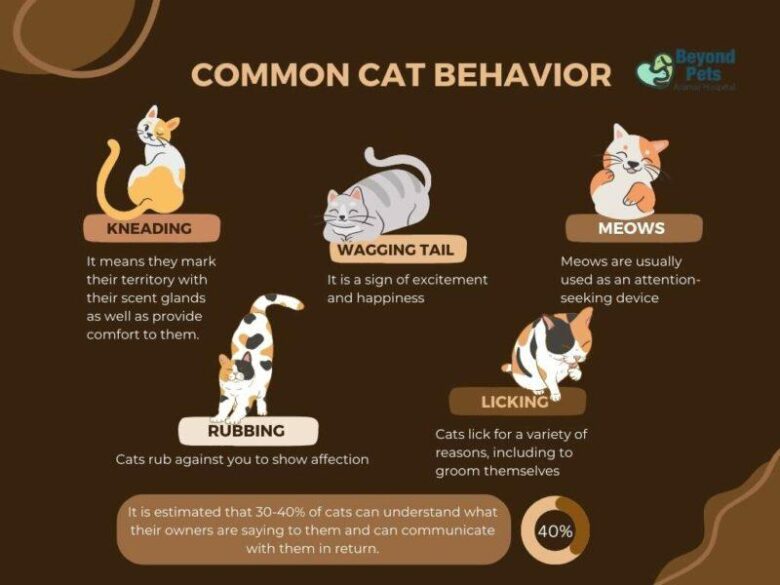Have you ever found yourself puzzled by your feline friend’s behavior? From their quirky habits to mysterious moods, cats can be fascinating yet enigmatic creatures. In this article, we delve into the world of cat behavior to unlock the secrets behind your four-legged companion’s actions. By gaining a deeper understanding of your cat’s behaviors, you can strengthen your bond and create a harmonious relationship with your feline friend. So, grab a seat, prepare to be enlightened, and let’s unravel the mysteries of cat behavior together.
– Decoding Feline Body Language: Understanding What Your Cat Is Trying to Tell You
Cats are notorious for being mysterious creatures, but if you pay close attention to their body language, you can start to unravel the secrets they’re trying to communicate. By understanding the subtle cues your feline friend is giving you, you can deepen the bond between you and your cat and ensure a happy and harmonious relationship.
One of the most common ways cats communicate is through their tail movements. A **tail held high** typically indicates a happy and content cat, while a **fluffed-up tail** may indicate fear or aggression. A **slow swish** of the tail may signify annoyance, while a rapid **flipping back and forth** could indicate excitement or playfulness.
Another crucial aspect of feline body language is their ears. A **relaxed posture with ears forward** generally means your cat is feeling calm and friendly. However, **pinned-back ears** can signal aggression or fear, while **twitching ears** may indicate irritation or anxiety. By paying attention to your cat’s ear movements, you can better understand their emotional state and respond accordingly.
– The Importance of Environmental Enrichment for a Happy and Well-Behaved Cat
Creating a stimulating environment for your cat is crucial for their overall well-being and happiness. Environmental enrichment provides mental and physical stimulation, preventing boredom and behavior problems. By understanding your feline friend’s instincts and needs, you can design the perfect environment to keep them content and well-behaved.
One key aspect of environmental enrichment is providing adequate mental stimulation for your cat. Cats are natural predators and they need opportunities to hunt, explore, and play. By incorporating interactive toys, puzzle feeders, and scratching posts, you can satisfy your cat’s hunting and playing instincts. This not only keeps them mentally engaged but also reduces stress and anxiety.
Additionally, environmental enrichment helps promote good behavior in cats. A well-stimulated cat is less likely to engage in destructive behaviors like scratching furniture or excessive meowing. By providing a variety of toys, hiding spots, and climbing structures, you can help your cat release energy in a healthy way. This leads to a happier and more well-behaved feline companion.
– Tips for Building a Strong Bond with Your Feline Companion
Understanding your feline friend can be a mysterious yet rewarding journey. Cats are complex creatures with unique behaviors that can sometimes be baffling to us humans. However, by delving into the world of cat behavior, you can strengthen your bond with your furry companion and create a harmonious relationship.
Here are some tips for building a strong bond with your feline companion:
- Respect their space: Cats are independent animals that value their personal space. Allow your cat to come to you for affection instead of forcing attention on them.
- Provide mental stimulation: Keep your cat entertained with toys, puzzles, and interactive games. Cats are intelligent creatures that need mental stimulation to stay happy and healthy.
- Establish a routine: Cats thrive on routine and predictability. Stick to a consistent feeding schedule and playtime routine to help your cat feel secure and content.
| Cat Behavior | Explanation |
|---|---|
| Kneading | Cats knead with their paws to show affection and mark their territory. |
| Purring | Cats purr when they are content and relaxed, but also when they are in pain or stressed. |
– Unraveling the Secrets of Cat Communication: Meows, Purrs, and More
Cats are known for being enigmatic creatures, often leaving their human counterparts puzzled by their various vocalizations and behaviors. But fear not, as we delve into the fascinating world of cat communication, you’ll soon become well-versed in deciphering your feline friend’s meows, purrs, and more.
Meows are undoubtedly the most common form of communication cats use to interact with humans. Each meow can convey a different message, such as hunger, affection, or even a demand for attention. Some cats are even known to develop a unique meow specifically reserved for their human, making it a truly personal form of communication.
On the other hand, purring is perhaps one of the most enchanting sounds cats produce. Contrary to popular belief, cats don’t just purr when they’re content – they also purr when they’re scared, injured, or in pain. This multifaceted vocalization serves as a comforting mechanism for cats, allowing them to self-soothe and communicate their needs to those around them.
In Summary
As we delve deeper into the mysterious world of cat behavior, we come to realize that our feline friends are truly fascinating creatures with a language all their own. By understanding their unique quirks and behaviors, we can cultivate a deeper bond with our four-legged companions. So next time your cat gives you a headbutt or kneads your lap, remember that they are simply communicating in their own special way. Embrace the mysteries of cat behavior and enjoy the endless adventures that come with being a cat parent. Who knows, you may just unlock a new level of connection with your purrfect friend.



